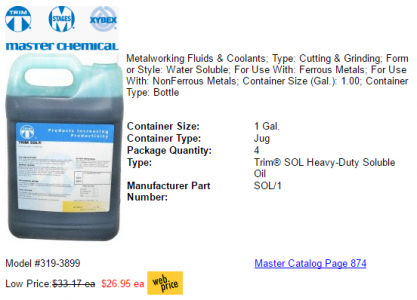Mark, Trim Sol has a FAQ on their site that addresses possible odor. I remember when I was in an R&D shop with large amounts of coolant, the machinists would change and clean out the sumps after 3 months or so. They did not use distilled or RO water, whereas I do.
I do not have any issues when using Trim Sol in a spray bottle for lathe and mill use, however when I add flood coolant to my bandsaw in a few weeks, I will do as Groundhog does and use a timed aquarium air pump. That will definitely help prevent the anaerobic bacterial from building up. (This is the source of the odor).
The problem with Trim Sol and other manufactures is the vast amount of products they offer. Certainly creates confusion of selection. I went with a general purpose, all around good performer, since I am not doing anything critical or high speed...hence SOL/1. Whereas others are using different Trim Sol selections, which work well too.
I suspect most of their products (as well as the other manufactures' designed cutting fluid pointed out here) work just as well. Remembering this thread was started by asking what we all were using for aluminum machining. Tap Magic, Rapid Tap, A9, are all designed for cutting/tapping of aluminum as well as Trim Sol in a spray bottle if you don't have flood coolant.
The point I wanted to make is there are properly designed cutting fluids available that are not expensive....even lower cost than WD-40, and will make a huge difference in your cutting/machining experience.
Why did I go with Trim Sol? I had a lot of wants:
I wanted something that would take the place of WD-40, something designed for machining.
I wanted something that worked for many metals..cause I'm lazy/cheap and did not want to have different formulas of Tap Magic, Rapid Tap, etc for different metals.
I wanted something for a low cost, yet perform well....did I mention I'm cheap?
I wanted something I could use in a spray bottle. I had been using WD-40 (bulk) in a spray bottle.
I wanted something that did did not smell bad when taking heavy cuts.
I wanted something that lasted a long time so I did not have to continually order or store many bottles.
I wanted something that I could use in a flooded coolant system.
The Trim Sol I went with is $2.45/gallon for a proven coolant/cutting fluid, that is very hard to beat. That is a lot cheaper than WD-40 (by almost 8:1) and cheaper than Kerosene.
Below is from Trim Sol's FAQ section:
___________________________________________________________________________________________________
5) Why does my coolant have an unpleasant smell?
An unpleasant coolant smell is most likely attributed to anaerobic bacteria. Bacteria produce waste products, which often contain sulfur and exude the "rotten-egg" smell. Bacteria are major contributors to coolant failure. They chemically alter coolants and destroy the lubricants and corrosion inhibitors in the process. They also pass off corrosive acids and salts into the coolant, which can lead to low pH and corrosion problems. The bacterial growth can be minimized by:
- Maintaining proper coolant concentration.
- Good housekeeping practices (cleanliness).
- Preventing or minimizing contamination.
- Good filtration of the coolant and continuously removing chips. Thorough, periodic sump clean-outs.
Oftentimes, "cover-ups" which are perfumes, can be used to mask odors but they are not a cure and their use can lead to more serious fluid problems later.
18) Why does the machine sump smell badly after a few days shut-down?
When a machine is shut down for a few days some of the tramp oil in the fluid separates and rises to the top of the sump sealing off the fluid from the air. Anaerobic bacteria grow and reproduce without the need of oxygen. As a matter of fact oxygen actually inhibits their growth. These bacteria in the stagnant fluid now begin to grow and release hydrogen sulfide (H2S) gas that dissolves in the coolant. When the coolant pumps are turned on at the end of the shut down the dissolved H2S is released to the atmosphere. H2S has the characteristic odor of rotten eggs and the human nose can detect it at the 1-2 parts per billion level. Talk to your Master Chemical District Manager or your TRIM® distributor about ways of controlling this persistent problem.

